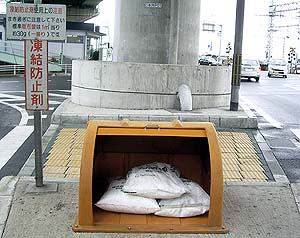Calcium chloride
[[File:||thumb]]
Calcium chloride is a chemical compound composed of calcium and chlorine. It is a white, crystalline substance that is highly soluble in water. Its chemical formula is CaCl2. Calcium chloride is notable for its wide range of applications, from medical treatments to food preservation and road maintenance.
Properties and Production[edit | edit source]
Calcium chloride exhibits several important physical and chemical properties. It is hygroscopic, meaning it can absorb moisture from the air, and is very soluble in water, releasing heat in an exothermic process. This compound can also be found in various states, including anhydrous (without water) and as a hydrated salt, with two or six molecules of water (dihydrate and hexahydrate, respectively).
The production of calcium chloride typically involves the reaction of limestone (calcium carbonate) with hydrochloric acid: \[CaCO_3 + 2HCl → CaCl_2 + CO_2 + H_2O\] Alternatively, it can be produced as a by-product in the Solvay process of synthetic sodium carbonate (soda ash) production.
Applications[edit | edit source]
Deicing and Dust Control[edit | edit source]
One of the most common uses of calcium chloride is as a deicing agent. Due to its hygroscopic nature and ability to lower the freezing point of water, it is effective in preventing ice formation on roads and sidewalks. It is also used for dust control on unpaved roads and in mining operations, as it can keep dust particles moist and prevent them from becoming airborne.
Food Industry[edit | edit source]
In the food industry, calcium chloride is used as a firming agent in canned vegetables, in cheese making as a source of calcium ions, and as an electrolyte in sports drinks. Its ability to absorb moisture also makes it useful as a desiccant to maintain dryness in packaging.
Medicine[edit | edit source]
In medicine, calcium chloride is used as an injectable solution to treat hypocalcemia (low blood calcium levels), magnesium intoxication, and certain cases of cardiac resuscitation where calcium can improve the efficiency of epinephrine.
Other Uses[edit | edit source]
Other applications of calcium chloride include its use in the manufacture of concrete, as a refrigeration brine in ice rinks and air conditioning systems, and in the oil industry to increase the density of solids-free brines. It is also used in swimming pools as a pH buffer and to increase water hardness.
Safety and Handling[edit | edit source]
While calcium chloride is generally considered safe for the aforementioned uses, it can be irritating to the skin and eyes upon contact. Inhalation of its dust can cause respiratory discomfort. Appropriate safety measures, including the use of personal protective equipment, are recommended when handling this chemical.
Environmental Impact[edit | edit source]
The environmental impact of calcium chloride is relatively low, especially when used responsibly. However, excessive application, particularly as a road deicer, can lead to increased chloride levels in nearby water bodies, potentially harming aquatic life.
Search WikiMD
Ad.Tired of being Overweight? Try W8MD's physician weight loss program.
Semaglutide (Ozempic / Wegovy and Tirzepatide (Mounjaro / Zepbound) available.
Advertise on WikiMD
|
WikiMD's Wellness Encyclopedia |
| Let Food Be Thy Medicine Medicine Thy Food - Hippocrates |
Translate this page: - East Asian
中文,
日本,
한국어,
South Asian
हिन्दी,
தமிழ்,
తెలుగు,
Urdu,
ಕನ್ನಡ,
Southeast Asian
Indonesian,
Vietnamese,
Thai,
မြန်မာဘာသာ,
বাংলা
European
español,
Deutsch,
français,
Greek,
português do Brasil,
polski,
română,
русский,
Nederlands,
norsk,
svenska,
suomi,
Italian
Middle Eastern & African
عربى,
Turkish,
Persian,
Hebrew,
Afrikaans,
isiZulu,
Kiswahili,
Other
Bulgarian,
Hungarian,
Czech,
Swedish,
മലയാളം,
मराठी,
ਪੰਜਾਬੀ,
ગુજરાતી,
Portuguese,
Ukrainian
Medical Disclaimer: WikiMD is not a substitute for professional medical advice. The information on WikiMD is provided as an information resource only, may be incorrect, outdated or misleading, and is not to be used or relied on for any diagnostic or treatment purposes. Please consult your health care provider before making any healthcare decisions or for guidance about a specific medical condition. WikiMD expressly disclaims responsibility, and shall have no liability, for any damages, loss, injury, or liability whatsoever suffered as a result of your reliance on the information contained in this site. By visiting this site you agree to the foregoing terms and conditions, which may from time to time be changed or supplemented by WikiMD. If you do not agree to the foregoing terms and conditions, you should not enter or use this site. See full disclaimer.
Credits:Most images are courtesy of Wikimedia commons, and templates, categories Wikipedia, licensed under CC BY SA or similar.
Contributors: Prab R. Tumpati, MD




